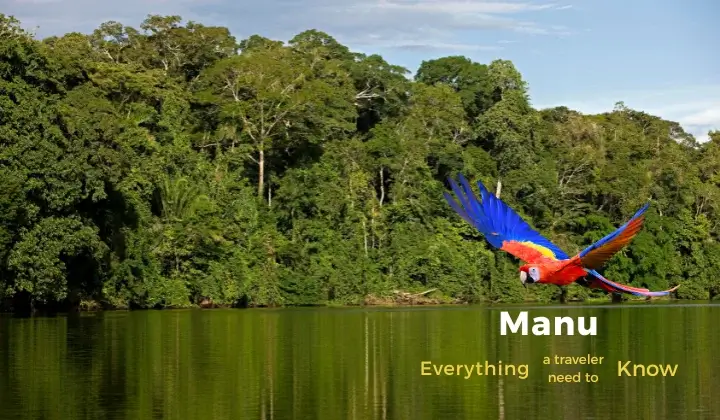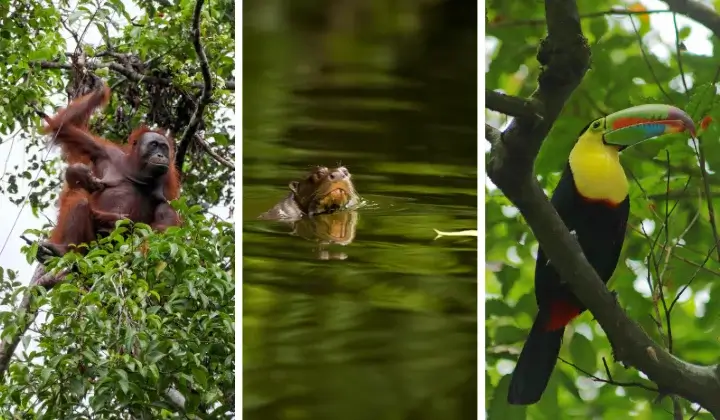Manu National Park is a destination shrouded in mystery. Hidden among its rivers and forests are ancient stories, myths passed down by the Amazonian people, and a natural wealth that makes it one of the most surprising places on the planet.
Those who dare to explore it discover that it is not just an immense jungle, but a territory full of secrets, where nature and history coexist in every corner. This blog gathers key information to understand why Manu remains a unique space worth exploring.

What is Manu National Park?
Manu National Park is one of the most important protected natural areas in Peru and the world. Located in the Madre de Dios region and part of Cusco, it stretches from the Andes to the lower Amazon. Its area exceeds 1.7 million hectares, allowing for a great diversity of ecosystems: puna, cloud forests, and tropical rainforest.
As a result, it is considered one of the most biodiverse places on the planet, home to thousands of species of plants, birds, mammals, amphibians, and reptiles. In 1987, it was declared a World Heritage Site by UNESCO.
Stories and history of the origin of the Manu
Before becoming a protected area, the Manu River was inhabited by various indigenous peoples who found sustenance in its rivers and forests. Chronicles from the first Spanish explorers mention that it was a vast territory, difficult to access, and full of mysteries.
Its name comes from the Manu River, a word that in native languages could mean “great mother” or “protective spirit,” related to the life this river brings to the jungle.
Myths of origin of the inhabitants of Manu
The Amazonian peoples who inhabit Manu preserve myths that explain the creation of their environment. One tells of the spirits of the forest giving early humans the seeds of the trees and forest animals so they would never lack food.
Other stories speak of invisible guardians, known as owners of the forest, who protect game and rivers. These stories are still passed down orally among communities such as the Matsiguenka, Harakbut, and Yine, who maintain a spiritual relationship with the forest.
The Inca conquest in Manu
During the expansion of the Inca Empire, the Manu region was a difficult territory to conquer due to its geography and the resistance of the Amazonian peoples. However, trade routes were established between the mountains and the jungle, known as the Antisuyu, which provided products such as exotic feathers, medicinal plants, and fruits.
The Manu region was part of that border between the Andean world and the Amazon, marked more by trade alliances than by direct conquest.
Expeditions, conflicts and protection of Manu in the 18th century
With the arrival of Spanish colonizers, attempts were made to explore Manu in search of gold and riches. There were failed expeditions and also clashes with the local population, who defended their territories. During the 18th century, access to these lands remained very limited due to the hostile terrain and strong indigenous resistance.
However, these difficulties helped ensure that much of Manu’s natural beauty remained intact until the 20th century, when its conservation began to be considered a national priority. In 1973, the Peruvian government declared it a National Park.
Manu National Park today
Today, Manu is a model of active conservation. It not only houses emblematic species such as the jaguar, the spectacled bear, and the macaw, but also native communities that live within the reserve, maintaining their traditions. Tourist access is regulated to ensure the protection of the ecosystem.
There are restricted areas, tourist zones, and sectors dedicated to scientific research. Visitors can hike trails, birdwatch, navigate rivers, and explore cloud forests and virgin jungles.
Recognitions that make Manu a unique place in the world
Manu is considered one of the most important biosphere reserves on the planet. UNESCO included it on its list of World Heritage Sites in 1987, and it is currently recognized as a living laboratory of biodiversity.
More than 1,000 bird species, 200 mammal species, and approximately 15,000 plant species have been recorded in the area. These recognitions have made Manu a destination for scientists, travelers, and nature lovers.

Plan your adventure in Manu National Park
How to get from Cusco to Manu?
The trip from Cusco to Manu is made in two sections: first by road, a 7- to 8-hour journey to Pilcopata or Atalaya, and then by river along the Alto Madre de Dios or Manu Rivers, which lead to the authorized areas of the park. Due to logistics, permits, and restrictions within the protected area, it is best to travel with a specialized agency.
At Inka Trail Expeditions Peru, we offer you a complete experience, with transportation, professional guides, and all the necessary authorizations so you can enjoy Manu without worries. Depending on your time, you can choose between:
This way, you can be sure to explore one of the most biodiverse places on the planet with a reliable service tailored to your trip.
Tickets and entrance fees to Manu
Where to buy admission tickets?
Entrance tickets to Manu National Park can only be purchased through the National Service of Natural Protected Areas (SERNANP) or through authorized travel agencies in Cusco and Madre de Dios. There are no ticket offices at the entrance, so reservations must be made before your trip.
What to do in Manu National Park?
Manu offers both natural and cultural activities. Some of the most recommended experiences are:
- Admire the Tres Cruces viewpoint:Located at 3,700 meters above sea level, this viewpoint offers one of the most unique sunrises in the world, where the clouds form a “sea” amidst the mountains.
- Visit the four lagoons: Juares, Brashco, Otorongo, and Salvador: Each lagoon displays a distinct ecosystem. The Otorongo lagoon, for example, has observation towers that allow you to see wildlife without disturbing its habitat.
- Admire the Pusharo petroglyphs: An archaeological site in the heart of the jungle, with mysterious stone figures that still have no definitive explanation.
- Marvel at the sightings of birds and wildlife: Manu is a paradise for birdwatchers: macaws, toucans, harpy eagles, and hundreds of other species. You may also see jaguars, giant otters, and various monkey species.
- Walk along trails full of life: Guided tours allow you to explore cloud forests, rivers, and streams, always accompanied by authorized guides who explain the richness of the ecosystem.
- Connect with local communities: In some areas, you can live with Amazonian communities, learning about their traditions, crafts, and customs.
- Visit the Arakbut village: The Arakbut are one of the most representative communities in Manu, known for their art, their relationship with the forest, and their history of cultural resistance.
- Visit the Matsiguenka interpretation centers: The Matsiguenka have spaces dedicated to showcasing their history, their subsistence practices, and the use of medicinal plants.
- Go sport fishing and canoeing: In authorized areas, sport fishing in rivers and lagoons is permitted, subject to conservation regulations.
- Navigate the Pongo de Copec: A natural canyon on the Madre de Dios River, surrounded by rock walls and lush vegetation. It is one of the most impressive landscapes in Manu.
- Visit the bird clay lick: Clay licks are shallow ravines where macaws and parrots come daily in search of minerals. Seeing this natural spectacle is one of the park’s most popular experiences.
- Exotic animals most anticipated by visitors: Among the most sought-after species are the jaguar, the spectacled bear, the giant otter, the harpy eagle, the tapir, and various species of monkeys and macaws. Manu is one of the few placeswhere you can observe this variety in the wild.
- Recommended nearby natural areas: If you’re planning a longer trip to the area, you can combine your visit to Manu with other nearby destinations such as:
- Tambopata National Reserve (Madre de Dios).
- Kosñipata Cloud Forest (Cusco).
- Bahuaja Sonene National Park, which shares the Amazonian ecosystem with Manu.
Recommendations for your trip to Manu
Tips for a safe and authentic experience
Manu is a protected natural area, and visitors must be responsible. It’s best to travel with authorized agencies, as they know the routes and have official permits. Don’t venture out alone, follow the guides’ instructions, and avoid straying from marked trails. Remember that the priority is to conserve biodiversity and ensure the safety of all visitors.
What to bring?
Your packing list should be practical, avoiding unnecessary items:
- Lightweight, quick-drying clothing.
- Rain poncho or raincoat.
- Hiking boots and sandals for resting.
- Insect repellent and sunscreen.
- Headlamp with extra batteries.
- Reusable water bottle.
- Personal medications and a basic first-aid kit.
- Avoid urban clothing, formal shoes, or makeup, as these are not useful in the jungle.
Manu Park Rules
Entry is regulated, and the following rules must be followed:
- Access is only permitted with authorized tour operators.
- No littering or leaving behind waste.
- No hunting, fishing, or collecting species without permission.
- No entry with alcoholic beverages or prohibited substances.
- Respect the tranquility of the wildlife by avoiding excessive noise.
Failure to comply with these rules may result in fines and immediate expulsion from the protected area.
Climate of Manu National Park
Manu’s climate changes markedly depending on the altitude. In the highlands, near the Tres Cruces viewpoint and the Kosñipata sector, mornings can be cold, with temperatures dropping to 5°C, especially in winter (June to August).
As you descend into the lowland forest, the environment becomes much warmer and more humid, with daytime temperatures hovering between 25°C and 35°C. Relative humidity is high, and rain is common, especially between November and April, the months of the wet season. This climatic variation is what makes the park’s incredible biodiversity possible.
Best time to visit Manu National Park
The best time to visit Manu is from May to October, when the rains lessen and the trails are more passable. During these months, visibility is best for observing wildlife and taking long hikes. It’s also the ideal time to enjoy the sunrise in Tres Cruces, as the “sea of clouds” phenomenon is more frequent.
During the rainy season, from November to April, although access can be complicated by flooding and mudflats, the jungle is at its most lush and full of life, which can also be attractive to those seeking a more intense experience.
Resting places inside Manu Park
Rest within the park is organized in eco-lodges and authorized camping areas. These spaces aim to reduce environmental impact while providing comfort to visitors. The lodges typically offer simple rooms, limited electricity, and meals based on local products.
Some of them are directly managed by native communities, which adds value to the experience, allowing travelers to live with and learn about Amazonian customs. Falling asleep listening to the sounds of the jungle is one of the most authentic memories of the trip.
Try the local cuisine in Manu
A visit to Manu also includes discovering the culinary riches of the Amazon. The most common dishes served in the lodges and communities are made with fresh, local ingredients. Some of the most notable are:
- Juane: rice wrapped in bijao leaves, accompanied by chicken or fish, ideal for excursions.
- Amazonian fish: such as doncella, gamitana, or paiche, prepared grilled, in broth, or fried.
- Tacacho con cecina: roasted and mashed green plantain accompanied by smoked meat.
- Masato: a traditional drink made from fermented cassava, consumed communally.
- Fresh fruits: such as copoazú, camu camu, guava, taperibá, and aguaje, which provide energy during the hikes.
Trying the local cuisine is not only part of the experience but also a way to support the communities that manage tourism services within the park.


